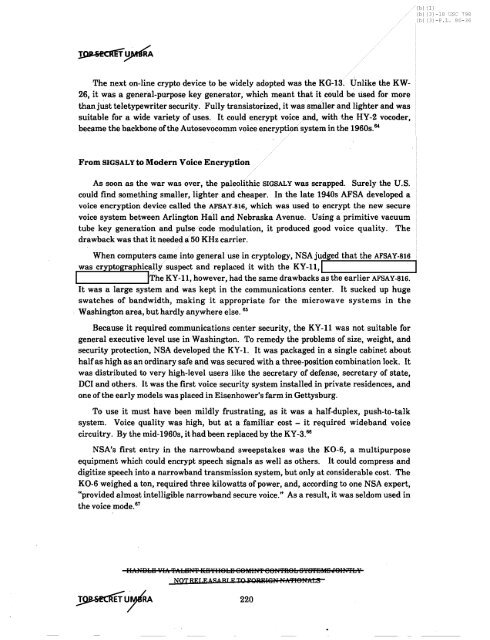American Cryptology during the Cold War - The Black Vault
American Cryptology during the Cold War - The Black Vault
American Cryptology during the Cold War - The Black Vault
Create successful ePaper yourself
Turn your PDF publications into a flip-book with our unique Google optimized e-Paper software.
Ib) (1)<br />
Ib) (3) -18 USC 798<br />
Ib) (3) -P.L. 86-36<br />
<strong>The</strong> next on-line crypto device to be widely adopted was <strong>the</strong> KG-13. Unlike <strong>the</strong> KW<br />
26, it was a general-purpose key generator, which meant that itc::ould be used for more<br />
thanjust teletypewriter security. Fully transistorized, it was smaller and lighter and was<br />
suitable for a wide variety of uses. It could encrypt voiceaIld, with <strong>the</strong> HY-2 vocoder,<br />
became <strong>the</strong> backbone of<strong>the</strong> Autosevocomm voice encryption system in <strong>the</strong> 1960s. 64<br />
From SIGSALY to Modern Voice Encryption<br />
As soon as <strong>the</strong> war was over, <strong>the</strong> paleolithic SIGSALY was scrapped. Surely <strong>the</strong> U.S.<br />
could find something smaller, lighter and cheaper. In <strong>the</strong> late 1940s AFSA developed a<br />
voice encryption device called <strong>the</strong> AJ;?5AY-816, which was used to encrypt <strong>the</strong> new secure<br />
voice system between Arlington Hall and Nebraska Avenue. Using a primitive vacuum<br />
tube key generation and pulse/code modulation, it produced good voice quality. <strong>The</strong><br />
drawback was that it needed a 50 KHz carrier.<br />
When computers came into general use in cryptology, NSAjudged that <strong>the</strong> AFSAY-816<br />
was cryPtographicallysuspect and replaced it with <strong>the</strong> KY-ll,I<br />
I<br />
I<strong>The</strong> KY-ll, however, had <strong>the</strong> same drawbacks al-s-t-h-e-e-a-r-li-e-r-A-F-S-A-Y--8-1-6.....I<br />
It was a large system and was kept in <strong>the</strong> communications center. It sucked up huge<br />
swatches of bandwidth, making it appropriate for <strong>the</strong> microwave systems in <strong>the</strong><br />
. Washington area, but hardly anywhere else. 65<br />
Because it required communications center security, <strong>the</strong> KY-ll waS not suitable for<br />
general executive level use in Washington. To remedy <strong>the</strong> problems of size, weight, and<br />
security protection, NSA developed <strong>the</strong> KY-l. It was packaged in a single cabinet about<br />
halfas high as an ordinary safe and was secured with a three-position combination lock. It<br />
was distributed to very high-level users like <strong>the</strong> secretary of defense, secretary of state,<br />
DCI and o<strong>the</strong>rs. It was <strong>the</strong> first voice security system installed in private residences, and<br />
one of<strong>the</strong> early models was placed in Eisenhower's farm in Gettysburg.<br />
To use it must have been mildly frustrating, as it was a half-duplex, push-to-talk<br />
system. Voice quality was high, but at a familiar cost - it required wideband voice<br />
circuitry. By <strong>the</strong> mid-1960s, it had been replaced by <strong>the</strong> KY_3. 66<br />
NSA's first entry in <strong>the</strong> narrowband sweepstakes was <strong>the</strong> KO-6, a multipurpose<br />
equipment which could encrypt speech signals as well as o<strong>the</strong>rs. It could compress and<br />
digitize speech into a narrowband transmission system, but only at considerable cost. <strong>The</strong><br />
KO-6 weighed a ton, required three kilowatts ofpower, and, according to one NSA expert,<br />
"provided almost intelligible narrowband secure voice." As a result, it was seldom used in<br />
<strong>the</strong> voice mode. 67<br />
IIANB15E VIA Wt15EN'f KEYIIe15E OeMIlff SeNTRe15 SYSlfEMSdeU,'f15Y<br />
NOT RELEASABI F TO i'Q~ISN NATI8I(AL3<br />
220
















